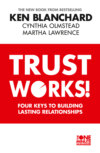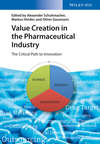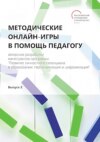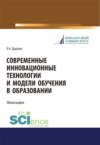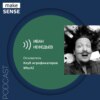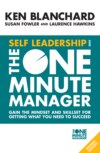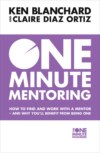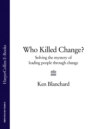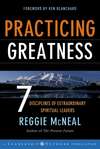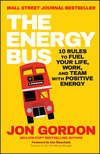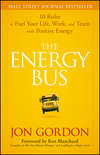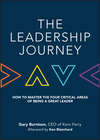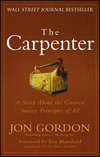Buch lesen: «Trust Works: Four Keys to Building Lasting Relationships»

Contents
Introduction by Cynthia Olmstead
Some Perspective Before You Read This Story
by Ken Blanchard
Part I—A Tale of Trust
Broken Trust
A Matter of Perception
Ready and Able
Believe It or Not
The Connection
It All Depends
A Terrible Blow
A Test of Trust
Moving On
How Trustworthy Do You Think You Are? Scoring Your Self-Assessment
Part II—Trust-Building Resources: Applying the ABCD Trust Model™ to Real Life
Trust Busters and Trust Boosters: Understanding How Behaviors Affect Trust
Checking Your Self-Perception: Invite Others to Assess You
Learning to Diagnose Trust Issues: How to Recognize Trust Busters
Learning to Have Trust Conversations: The Importance of Perception
Applying the ABCD Trust Model™ to Your Own life
Rebuilding Damaged Trust
Building Trust in Organizations: A Message for Leaders
Appendix: How Trustworthy Do You Think I Am?
Acknowledgments
About the Authors
Advance Praise for Trust Works!
Also by Ken Blanchard
Services Available
Join Us Online
Copyright
About the Publisher
Introduction
by Cynthia Olmstead
Creator of TrustWorks!™
As an organizational change consultant, I help business leaders identify where they are heading, work with them to build a strategic plan, and bring the rest of the organization into alignment so that everyone is pulling together to accomplish shared goals. Some organizations find this an arduous process fraught with setbacks and sometimes even failure. Other organizations are able to implement the changes quickly and move the process along smoothly.
A few years ago I began to wonder: Why were some companies successful in implementing change while others were not? Was it the leadership? If so, what was the key factor that allowed some leaders to get people to work together to bring about the desired changes, while others failed?
Somewhere flying over Kansas on one of my many trips from the West Coast to the East, a lightbulb came on: this key factor was trust. But what is trust? How do we describe it? Does trust mean the same thing to you as it does to me? If not, how can we talk about it?
To begin answering those questions, I started asking people in my sessions what symbol they would use to represent trust. People came up with an assortment of answers: a heart, a newborn baby, a handshake, a wedding ring, a cross, the American flag. The reactions to these symbols varied wildly. Some said, “I just went through a divorce, so wedding rings don’t mean trust to me.” Or “The flag isn’t seen as a trust symbol to people in some parts of the world.”
It became evident to me that trust means different things to different people based on their experiences. This begged the question: How could we ever talk about and resolve trust issues if we were seeing them only through our own lenses? Clearly, we needed a common framework, a model that created a mutual language for trust.
I began an intensive search for that, and along the way I found some interesting academic research with sophisticated models. But they were too complicated to use at all levels of an organization, from the C suite to the front line. After six years of research—including market analysis and focus groups with CEOs, managers, and associates—I became convinced that trust was something that grew when certain behaviors were present. But which behaviors?
Working from the premise that trust is based on behaviors, I set up flip charts in my office so that during discussions with clients, colleagues, and friends I could document behaviors they thought would either build or erode trust. As the lists grew long, I realized that the behaviors fell into four main groups: Able (demonstrate competence), Believable (act with integrity), Connected (care about others), and Dependable (maintain credibility). Thus the ABCD Trust Model™ was born!
Our intention in writing this book is to raise your awareness about the trust issues in your life as well as give you the language and tools to resolve them. Our hope is that you will use what you learn to build productive, joyful relationships—and that you’ll share what you learn with others, so they can do the same.
Some Perspective Before You Read This Story
by Ken Blanchard
Coauthor of The One Minute Manager® and Leading at a Higher Level
Trust is a delicate thing. It takes a long time to build, yet you can blow it in a matter of minutes. All it takes is one incident of behaving inconsistently with what someone considers trustworthy behavior for that person to pull away from you.
These days there’s a lot of talk about trust and even more talk about the lack of it. But people need to see trust in action more than they need to hear about it. In other words, your walk is more important than your talk. As Cindy pointed out in her introduction, this is where the tricky part comes in, because:
Trust is in the eye of the beholder.
What does that mean? It means that you can be completely unaware that your behavior is eroding the trust of those around you. What looks like fine behavior to you could make your friend, spouse, boss, employee, or constituent downright wary.
Because we see trust behaviors through our own filters, we need to have a common language for trust so we can talk together about what it is and what it isn’t. We have created the ABCD Trust Model™ to give you a way to begin having conversations about trust, not only in the business arena, but also in your personal life.
Ever since I wrote The One Minute Manager with Spencer Johnson and helped him in his writing of Who Moved My Cheese?, I have found that writing parables is the best way for me to live one of my missions in life, which is to be “a loving teacher and example of simple truths who helps myself and others to live more effective lives.” That’s why the first part of this book is a parable about how the lack of trust between a cat and a dog threatens the tranquillity of an animal-friendly family.
A story about a cat and a dog—is this meant to be a children’s book? No. While you can share the parable with your kids to start a dialogue about trust, the story is intended for adults. In fact, we hope you’ll see a bit of yourself—and some humans you know—in the story of Woof and Whiskers.
After reading the parable, you’ll be ready to review the trust-building resources in Part II. Here’s where you’ll learn to assess your strengths and weaknesses in the area of trust. You’ll find out about Trust Boosters and Trust Busters. You’ll also see how the ABCD Trust Model™ applies to real-life situations and learn the challenging art of beginning conversations about trust issues. Finally, you’ll discover the steps to rebuilding trust that’s been damaged.
We hope you’ll find the story a fun way to learn about trust. So lighten up, get in touch with your inner child, and enjoy A Tale of Trust.
Der kostenlose Auszug ist beendet.
